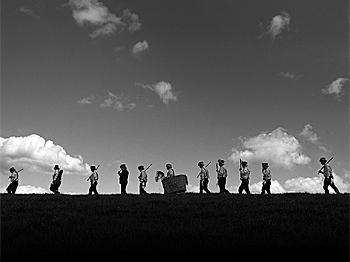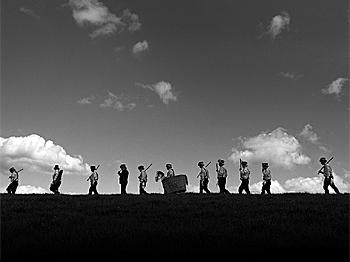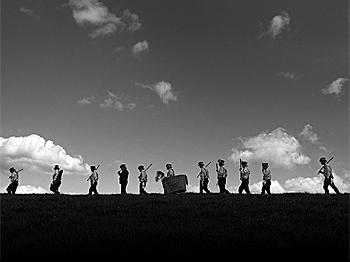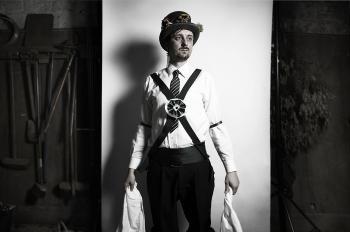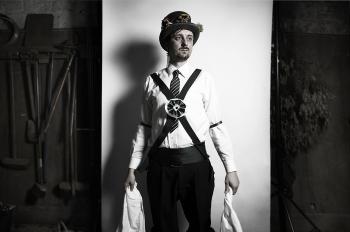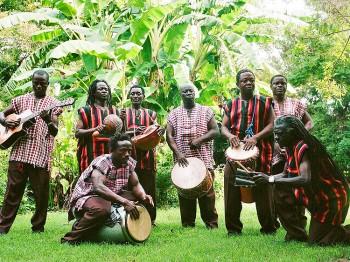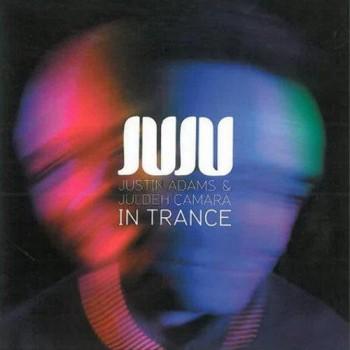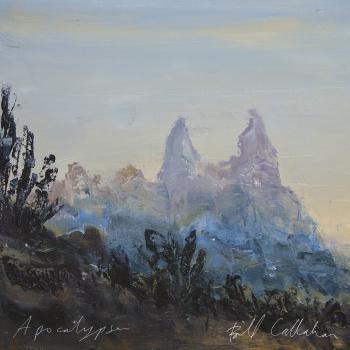One of the country’s leading venues for the arts, London’s Southbank Centre, played host to “5000 Morris Dancers” last weekend, using mixed media of film, art, dance, music and debate to shine some much needed light on the oft-maligned English dance tradition of morris.
The great strength of this festival was to acknowledge the complex nature of the morris revival seen during the last 40 years, and to gentle tease out the various interconnected threads, weaving together a full and satisfying picture.
Morris dancing was once the mainstay of rural identity throughout the length and breadth of England, but suffered bitterly from the joint blows of first the industrial revolution, and later the First World War.
Particularly poignant was the tale of the Adderbury Morris Men, brought into sharp focus by a charming and moving documentary film by Tim Plester and Rob Curry, premiered at the weekend-long event.
One of the few traditions to survive the disintegration of village community that accompanied England’s rise to become the world’s first industrialised nation, the entire Adderbury team went to the battlefields of The Somme. Only one man returned.
After lying dormant for many years, the tradition eventually resurfaced in the Oxfordshire village, and became an integral component of Tim Plester’s childhood, particularly with both his father and uncle being key members of the local morris team.
Way of the Morris gently and evocatively charts Tim’s journey, from teenage resistance to his family and community traditions, to eventual acceptance and participation. In so doing, we gain a clear and compelling insight into the profound role of morris dancing within village life.
The great strength of this festival was to acknowledge the complex nature of the morris revival seen during the last 40 years, and to gentle tease out the various interconnected threads, weaving together a full and satisfying picture.
Morris dancing was once the mainstay of rural identity throughout the length and breadth of England, but suffered bitterly from the joint blows of first the industrial revolution, and later the First World War.
Particularly poignant was the tale of the Adderbury Morris Men, brought into sharp focus by a charming and moving documentary film by Tim Plester and Rob Curry, premiered at the weekend-long event.
One of the few traditions to survive the disintegration of village community that accompanied England’s rise to become the world’s first industrialised nation, the entire Adderbury team went to the battlefields of The Somme. Only one man returned.
After lying dormant for many years, the tradition eventually resurfaced in the Oxfordshire village, and became an integral component of Tim Plester’s childhood, particularly with both his father and uncle being key members of the local morris team.
Way of the Morris gently and evocatively charts Tim’s journey, from teenage resistance to his family and community traditions, to eventual acceptance and participation. In so doing, we gain a clear and compelling insight into the profound role of morris dancing within village life.
Speaking after the screening, one of the morris men said simply: “I sang in the village choir, I played for the village football team, and I dance in the village morris side. That’s how it is.” Particularly touching was the obvious respect and admiration the younger men had for the elders in their community, something often sadly lacking these days.
Saturday night’s entertainment saw a live performance by the young stars of today’s folk revival, presenting a heart-felt rendition of seminal folk rock album Morris On.
The common themes of the weekend wove together magically here, as it was this 1972 LP that led to the reemergence of morris dancing in Adderbury. Several songs were drawn from the Adderbury tradition, and its popularity led to a morris dance display outside the house of the one lone survivor from the pre-World War One team, by then an old man. The event reawakened village pride in their shared heritage, and the rest, as they say, is history.
Jim Moray, Sam Sweeney, Saul Rose and others not only faithfully performed Morris On in its entirety, but also spoke lovingly of the role the album had played in their formative years, and the musical inspiration it provided them.
But before the younger generation conveyed their reverence, the chief architect of the original LP, Fairport Convention and Steeleye Span legend Ashley Hutchings, spoke in detail of the history of the recording.
It was fascinating to hear of his “eureka” moment, visiting Cecil Sharps house and hearing the one existing album of morris tunes, the first properly English traditions he had listened too, rather than the Scottish and Welsh Celtic traditions that had informed Fairport Convention up to that point.
The vigour and relevance of morris dancing had also been displayed on Friday night, with the Demon Barber Roadshow showing exactly why they were winners of last years BBC Radio 2’s Best Live Act award.
The high point was perhaps the Rapper dancing, a morris tradition from the mining communities of North East England, performed at speed by five dancers linked with short two-handled flexible swords called rappers. Putting firmly to bed the notion of morris dancers as somehow effeminate, these lads looked more like a local rugby side, and the whole crowd cheered as finally separated themselves and held up the “sword lock” triumphantly.
Mixing fiddle, melodeon and acoustic guitar with a funky electric bass and even at times a human beat box, The Demon Barbers put on a great performance. The female clog dancers were fantastic, Bryony Griffith’s soared clearly through the auditorium, and the interludes were humerous and down to earth.
It was everything a folk band should be—fun, vibrant and engaging, really harking back to a lost sense of community when the whole village would celebrate and dance together.
Throughout the course of the weekend many different morris teams strutted their stuff, among them Hammersmith Morris Men, Pecsaetan Morris, and Boggart’s Breakfast, to name but a few. They performed mainly on Queen’s Walk, alongside the river Thames.
There was also an accomplished art exhibition by graphic designer David Owen, one of the key organisers for the event as a whole. By embellishing iconic images with a morris twist, viewers were treated to World War One recruitment posters, Starwars stormtroopers, A Clockwork Orange, and even The Clash, transformed into emblems of morris dancing, a fun and light-hearted way of reestablishing time-old English traditions within our modern cultural spectrum.
The final coup of the “5000 Morris Dancers” festival was a Sunday night concert by all-star folk collective The Imagined Village, featuring Simon Emmerson, Martin Carthy, Eliza Carthy, among others.
Saturday night’s entertainment saw a live performance by the young stars of today’s folk revival, presenting a heart-felt rendition of seminal folk rock album Morris On.
The common themes of the weekend wove together magically here, as it was this 1972 LP that led to the reemergence of morris dancing in Adderbury. Several songs were drawn from the Adderbury tradition, and its popularity led to a morris dance display outside the house of the one lone survivor from the pre-World War One team, by then an old man. The event reawakened village pride in their shared heritage, and the rest, as they say, is history.
Jim Moray, Sam Sweeney, Saul Rose and others not only faithfully performed Morris On in its entirety, but also spoke lovingly of the role the album had played in their formative years, and the musical inspiration it provided them.
But before the younger generation conveyed their reverence, the chief architect of the original LP, Fairport Convention and Steeleye Span legend Ashley Hutchings, spoke in detail of the history of the recording.
It was fascinating to hear of his “eureka” moment, visiting Cecil Sharps house and hearing the one existing album of morris tunes, the first properly English traditions he had listened too, rather than the Scottish and Welsh Celtic traditions that had informed Fairport Convention up to that point.
The vigour and relevance of morris dancing had also been displayed on Friday night, with the Demon Barber Roadshow showing exactly why they were winners of last years BBC Radio 2’s Best Live Act award.
The high point was perhaps the Rapper dancing, a morris tradition from the mining communities of North East England, performed at speed by five dancers linked with short two-handled flexible swords called rappers. Putting firmly to bed the notion of morris dancers as somehow effeminate, these lads looked more like a local rugby side, and the whole crowd cheered as finally separated themselves and held up the “sword lock” triumphantly.
Mixing fiddle, melodeon and acoustic guitar with a funky electric bass and even at times a human beat box, The Demon Barbers put on a great performance. The female clog dancers were fantastic, Bryony Griffith’s soared clearly through the auditorium, and the interludes were humerous and down to earth.
It was everything a folk band should be—fun, vibrant and engaging, really harking back to a lost sense of community when the whole village would celebrate and dance together.
Throughout the course of the weekend many different morris teams strutted their stuff, among them Hammersmith Morris Men, Pecsaetan Morris, and Boggart’s Breakfast, to name but a few. They performed mainly on Queen’s Walk, alongside the river Thames.
There was also an accomplished art exhibition by graphic designer David Owen, one of the key organisers for the event as a whole. By embellishing iconic images with a morris twist, viewers were treated to World War One recruitment posters, Starwars stormtroopers, A Clockwork Orange, and even The Clash, transformed into emblems of morris dancing, a fun and light-hearted way of reestablishing time-old English traditions within our modern cultural spectrum.
The final coup of the “5000 Morris Dancers” festival was a Sunday night concert by all-star folk collective The Imagined Village, featuring Simon Emmerson, Martin Carthy, Eliza Carthy, among others.

